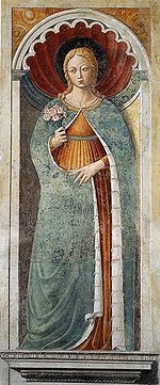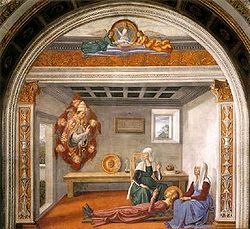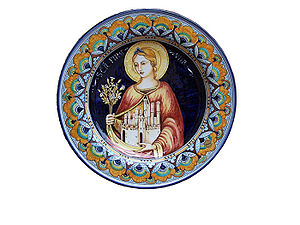
Saint Fina
Encyclopedia


Italy
Italy , officially the Italian Republic languages]] under the European Charter for Regional or Minority Languages. In each of these, Italy's official name is as follows:;;;;;;;;), is a unitary parliamentary republic in South-Central Europe. To the north it borders France, Switzerland, Austria and...
Roman Catholic girl who is venerated in the Tuscan town of San Gimignano
San Gimignano
San Gimignano is a small walled medieval hill town in the province of Siena, Tuscany, north-central Italy. It is mainly famous for its medieval architecture, especially its towers, which may be seen from several kilometres outside the town....
.
Life
Finadei Ciardi was born in San Gimignano on 1238. Daughter of Cambio Ciardi and Imperiera, a declined noble family, she lived all her existence in a humble house located in the historic centre of the famous “city of beautiful towers” (today the small road on which her house stands takes her name). There is little record of the first ten years of her life, and what information we have comes from legends narrated after her death. Some documents say that she was very devoted to the Virgin and she went out only to attend mass. She was said to be extraordinarily kind.In 1248 Fina’s life was changed by a serious illness, which began, progressively, to paralyse her (probably a form of tuberculosis
Tuberculosis
Tuberculosis, MTB, or TB is a common, and in many cases lethal, infectious disease caused by various strains of mycobacteria, usually Mycobacterium tuberculosis. Tuberculosis usually attacks the lungs but can also affect other parts of the body...
like osteomyelitis
Osteomyelitis
Osteomyelitis simply means an infection of the bone or bone marrow...
). Her deep faith relieved her pain. She refused a bed and chose instead to lie on a wooden pallet. According to her legend, during her long sickness her body became attached to the wood of the table, and worms and rats fed on her rotting flesh. During her illness, she lost her father and later her mother died after a fall. In spite of her misfortune and poverty she thanked God and expressed a desire that her soul might separate from the body in order to meet Jesus Christ.
Fina's immense devotion was an example to all the citizens of San Gimignano, who frequently visited her. Visitors were surprised to receive words of encouragement from a desperately ill young girl who was resigned to the will of God.
On March 4, 1253, after five years of sickness and pain, while her nurses Beldia and Bonaventura were waiting for her to pass away, Saint Gregory the Great appeared in Fina’s room and predicted that she would die on the 12th of March. Fina died on the predicted date. She was only 15 years old.
Miracles and legends
The most important miracle is the vision of Saint Gregory also because Fina died on Saint Gregory day (12 March) as he predicted.When Fina’s body was removed from the pallet, the people who were there saw white violets bloom from the wood and smelt a fresh flower fragrance through the whole house. The violets grew on the walls of San Gimignano too and still today they grow there. For this reason the people of San Gimignano call them “The Saint Fina violets”.
The young girl’s body was brought to the Pieve Prepositura and during the transfer all the people said “The Saint is dead!”.
For several days pilgrims went to the Pieve to see Fina’s remains and in the same period there were many evidences of her curative power. One was her nurse Beldia. The woman had a paralysed hand for the labour in supporting Fina’s head during her sickness. While she was near the body, the dead young girl cured Beldia’s hand.
Legends say that, at the exact moment of Fina’s passing away, all the bells of San Gimignano rang without anyone touching them.
Many sick people who visited her grave during the following years were cured and some of these became some of the most fervent apostles of S. Fina’s worship.
The decision of Fina to lie down on a wood table is still a mystery. Some documents tell about her sympathy for a soldier: before her sickness she received an orange from him as love pawn. After the disappointment of her parents for Fina having accepted the present she might have chosen the pain.
Another legend tells that during a walk with two of her friends she heard another young girl cry. Smeralda, this is her name, had broken a pitcher that her mother had given her in order to fill with water from Fonti. While she was stopped to play with other children, she forgot the pitcher on the ground which unfortunately rolled down and broke. Fina told her to arrange the pieces and put them under the water: the pitcher became complete and full of water.
Another anecdote about Fina’s miracles is the one of Cambio di Rustico: the Ciardi family’s neighbor. The man, a few years after Fina’s death on March 12 when all people had stopped working in order to remember the poor young girl, went to cut the wood and unfortunately hurt his leg. Suffering for his pain he asked forgiveness of Saint Fina and was very sorry for not having respected the holy day. Then his cut disappeared.
Other miracles attributed to Fina are mentioned in some stories, paintings, poems and in notary documents.
Festive days
Saint Fina is celebrated in San Gimignano on March 12, the anniversary of her death. This has been an official festive day since 1481.Two years before (1479), the little patron saint was implored to stop the plague: the calamity stopped and this miracle occurred again in the same period of 1631. This happened on the first Sunday of August and still today Saint Fina is celebrated twice in the town during the year.
On both days her relics are carried in procession in order to bless the town.
Her example of devotion has been handed down during times by the people of San Gimignano through her worship, but in spite of the name “Saint” she was not canonized. So, as written in some paintings dedicated to her, it would be correct to call her Blessed Fina. In fact the official patron saint of her town is still Saint Gimignano .
The hospital
The most important thing “produced” in memory of Saint Fina is the “spedale” (hospital) who took her name and was built in 1255 thanks to donations given at her tomb.The hospital gave hospitality to old and poor people and pilgrims too. It became in the following century one of the best in Tuscany. The building changed its name in 1816 and remained in function until the end of 20th century. In the hospital’s chapel, the original oak wood table where Saint Fina lay down for five years is preserved.
Evidences
The most important monument dedicated to Saint Fina is the Chapel (built by Giuliano da Maiano in 1468 and consecrated in 1488) located inside the Collegiata di San GimignanoCollegiata di San Gimignano
thumb|300px|View of the Collegiata.The Collegiata is the main church of San Gimignano, Tuscany, central Italy, situated in the Piazza del Duomo at the town's heart. It was once the Duomo , but since San Gimignano no longer has a bishop it has reverted to the status of a collegiate church.The first...
where, inside the altar (built by the brother Benedetto da Maiano), the bones are kept. On the left and right walls of the Chapel we can see two frescoes painted by Domenico Ghirlandaio
Domenico Ghirlandaio
Domenico Ghirlandaio was an Italian Renaissance painter from Florence. Among his many apprentices was Michelangelo.-Early years:Ghirlandaio's full name is given as Domenico di Tommaso di Currado di Doffo Bigordi...
: one shows the vision of St. Gregory; the other shows the funeral where the violets in blosom on the towers are represented. We also see an angel ringing the bells, Beldia’s cured hand and the self portrait of the painter and his brother-in-law Mainardi, who painted the Chapel’s ceiling. On the altar there is a bust with Saint Fina’s relics inside.
Inside the Civic Museum of San Gimignano there is a wood tabernacle (by Lorenzo di Nicolò de Martino 1402) where the Saint Fina is painted with the town on her lap, St. Gregory icon and some her anecdotes of life. Another important image of Fina is in the nearby St. Agostino Church painted by Benozzo Gozzoli
Benozzo Gozzoli
Benozzo Gozzoli was an Italian Renaissance painter from Florence. He is best known for a series of murals in the Palazzo Medici-Riccardi depicting festive, vibrant processions with wonderful attention to detail and a pronounced International Gothic influence.-Apprenticeship:He was born Benozzo di...
. Many other artists were inspired by Saint Fina’s life (Piero del Pollaiolo, Pier Francesco Fiorentino etc.). In others small churches in the countryside other painting about Saint Fina were discovered.
The most credited biographer of Saint Fina is Fra’ Giovanni del Coppo (“Historia vita et morte di Sancta Fina da San Gimignano”, written on 14th century and translated from Latin by Jacopo Manducci on 1575), who lived closest in time to Saint Fina. Many others have tried to tell Saint Fina’s life (Enrico Castaldi, Giovanni Bollando, Filippo Buonaccorsi, Teodoro Ferroni, Ignazio Malenotti, Luigi Pecori, Ugo Nomi Veronesi Pesciolini, Enrico Fiumi).
The best and most updated book is “Fina dei Ciardi”, written by Prof.ssa Iole Imberciadori Vichi in 1979: a deep research of all documents and biography existing in San Gimignano archives.

